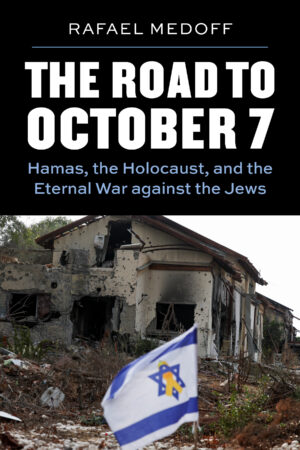A major front-page article in the New York Times this week strongly criticized Israel’s bombing of an Iranian torture center, even going so far as to suggest that the Israeli strike may have been a war crime. One wonders how the Times would have responded if the United States had done to Auschwitz what Israel did to the barbaric Evin prison in Tehran.
While Evin was not a death camp, and the brutalization of prisoners there was not another Holocaust, the bombing and its aftermath raise some of the same questions with which we grapple in ongoing discussions about the Allies’ failure to attack Auschwitz.
Even as it disparaged the Israeli bombing raid, the New York Times acknowledged that Evin was “a singular symbol of oppression,” where Iran’s rulers “punish dissent with detention, interrogation, torture and execution.”
The lengthy Times article mentioned that the bombs hit “the infamous 209 ward controlled by intelligence forces,” but it failed to explain why that ward is infamous. For that, one must look elsewhere, such as Hengameh Haj Hassan’s gripping 2013 memoir, Face to Face with the Beast: Iranian Women in Mullah’s Prisons.
Hassan and five other women were confined in a Ward 209 cell so small “that there wasn’t room enough to stretch out” to sleep. Some were political dissidents. One was a 16-year-old girl jailed for possessing a romance novel. The prisoners’ clothes were filthy “because of torture and bleeding wounds.” They shared a single decrepit toothbrush. The food consisted of one barely edible meal daily.
All the women in Hassan’s cell were beaten and tortured regularly. The officers who questioned Hassan boasted that they were “better at torturing and interrogating” than their colleagues. She endured unimaginable suffering, and also witnessed numerous “scenes of sexual humiliation,” including officers “raping girls before they executed them.”
The centerpiece of the New York Times story was the accusation that Israel’s bombing of Evin harmed some innocent bystanders. How many of them were killed or injured is impossible to know, because the Times relied partly on information from the Iranian government. The total number appears to be in the dozens, including some prisoners and relatives who were visiting them.
Kanal 13, an independent news outlet based in neighboring Azerbaijan, has broadcast video on YouTube that it said shows prisoners escaping from Evin as a result of the bombing. How many escaped may never be known.
When the Israeli government decided to strike at Iran’s nuclear facilities, it had no military reason to come to the aid of imprisoned Iranian dissidents. Attacking Evin was strictly a humanitarian gesture.
Unfortunately, Israel has not yet invented bombs that only blow the locks off prison cells or kill only the guards. Meaning that hitting the prison could endanger the lives of some innocent bystanders. But it could also mean freedom and life for many others.
The Allies faced similar dilemmas during World War II, yet that never stopped them from bombing necessary targets.
In February 1944, British fighter-bombers attacked the Amiens prison in German-occupied France, where the Nazis were holding French resistance fighters. The planes struck such narrow targets as a guardhouse and specific walls. As a result, 258 prisoners escaped. But 102 were killed.
The New York Times article about the Amiens raid did not contain even a hint of criticism. Nor did other media coverage of the bombing. An official of the World Jewish Congress clipped out the Times article and sent it to U.S. Assistant Secretary of War John McCloy, with a note describing the raid as “exactly the kind of assault which we have been asking for to free the doomed inmates of the German slaughter camps.” Roosevelt administration officials rejected such requests from dozens of officials of Jewish organizations.
Assaults such as the one on Amiens were known as “precision bombing,” but of course, there was a limit to how precise they could be. As in all wars, bystanders were sometimes harmed.
In April 1944, for example, the British targeted an archive in The Hague where the Germans stored documents that were potentially harmful to the Dutch resistance. The bombers destroyed the building and an adjacent SS barracks, but 64 archivists and passersby were killed. That August, American planes bombed a rocket factory inside the notorious Buchenwald concentration camp. They demolished the factory and killed about 100 SS officers and their family members, but an estimated 388 slave laborers in the factory were killed, and more than 1,000 were wounded.
Two months later, the British bombed Gestapo headquarters in northeastern Denmark. They destroyed crucial files and killed dozens of Germans. Two prisoners from the Danish resistance escaped, but a third was killed in the bombing. Stray bombs hit an adjacent building, killing ten civilians. Five months after that, the British bombed Gestapo headquarters in Copenhagen, leveling the building and enabling eighteen Danish prisoners to flee. Still, some bombs accidentally hit a nearby school, killing about 125 civilians.
American planes repeatedly bombed the synthetic oil factories in the industrial zone of Auschwitz, even though the Allies knew that about 600 British POWs were being held there. Thirty-eight of them were killed when the U.S. bombed those factories on August 20, 1944.
The choice for Israel was to do what the international community has always done about Iranian oppression—nothing—or to take action to interrupt the mass torture, even at the risk of harming some bystanders. The Israelis made the morally correct choice, even though Amnesty International says it was a “war crime.” The Israelis accomplished in minutes more than all of Amnesty’s crocodile tears press releases about Evin ever did.
 (Dr. Medoff is the founding director of The David S. Wyman Institute for Holocaust Studies and the author of more than 20 books about Jewish history and the Holocaust. His book The Road to October 7: Hamas, the Holocaust, and the Eternal War Against the Jews will be published on October 1, 2025, by The Jewish Publication Society / University of Nebraska Press.
(Dr. Medoff is the founding director of The David S. Wyman Institute for Holocaust Studies and the author of more than 20 books about Jewish history and the Holocaust. His book The Road to October 7: Hamas, the Holocaust, and the Eternal War Against the Jews will be published on October 1, 2025, by The Jewish Publication Society / University of Nebraska Press.
The Road to October 7 examines what paved the way for the October 7, 2023, attack on Israel and its aftermath.
Readers will emerge with essential insights on the Hamas attack, antisemitic education in Palestinian Arab society, pro-Hamas groups on U.S. campuses, the responses of women’s and human rights organizations to mass sexual violence, misconceptions and fabrications about Israel’s conduct in the ensuing war, and why October 7 needs to be viewed as one segment of both the century-long Palestinian Arab war and the centuries-old international war against the Jewish people.





